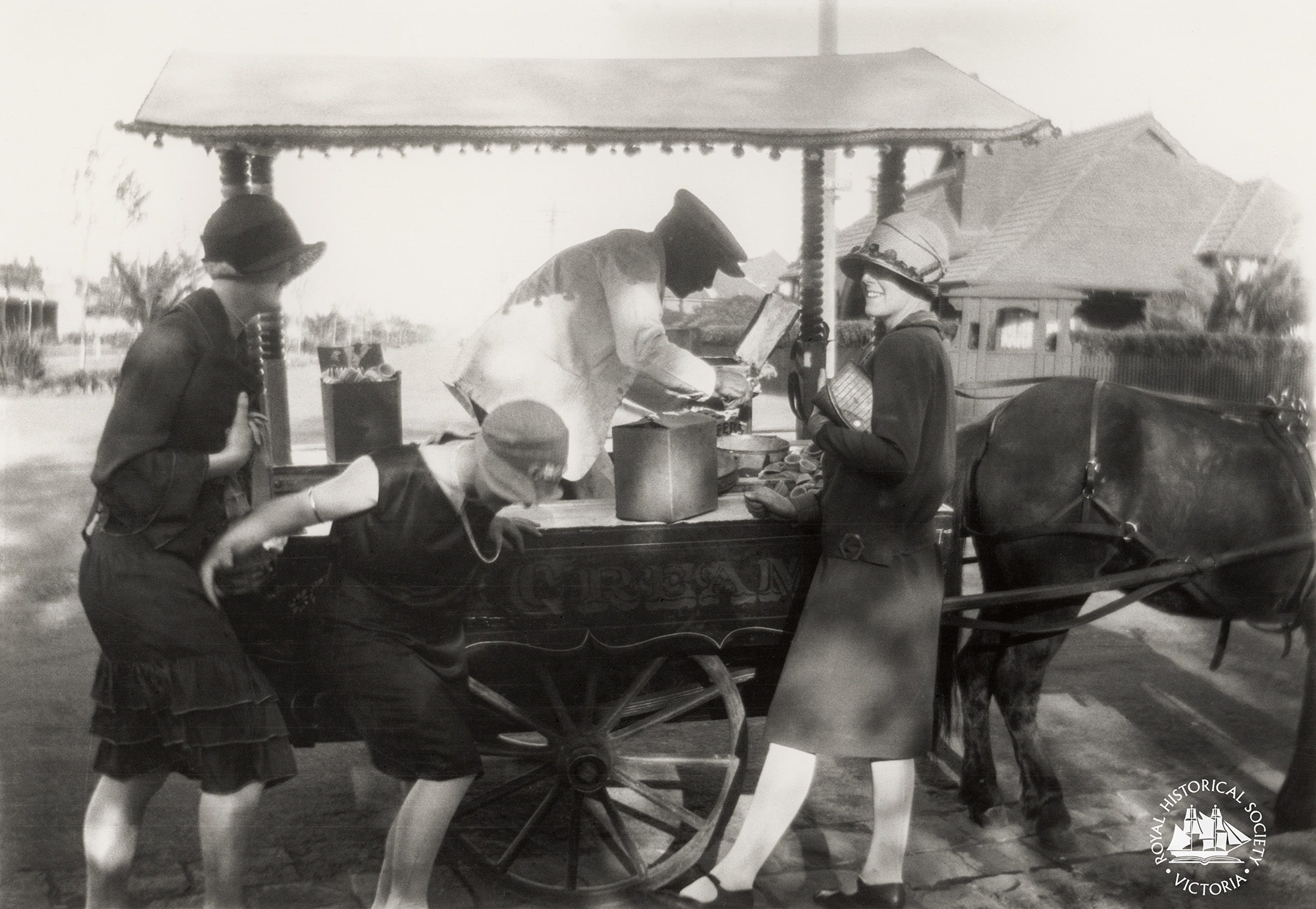
Image caption:
RHSV S-389: Ice-cream vendor at Princes Park, Carlton North, serving three female customers, c. 1925.
Pictured from left to right: Vera Martin, Rita Martin, and Jessie Key.
The sight of people enjoying a cool ice-cream on a warm day is one that could have been found in any Australian town since ice-cream first became widely available in the late nineteenth century. Indulging in this sweet treat is a delicious way to keep cool on a fun day out as these three young women, in Princes Park, Carlton North, demonstrate. But this tempting treat might not have been as innocent as it appeared, and could have led to disaster for both the buyers and the seller as various news reports from the Trove newspaper archive attest.
In the days before health and food safety standards, ice-cream could be produced and sold by anyone who had access to the ingredients. Small sellers often made batches of ice-cream in the backs of houses and other spare spaces where it could come into contact with dirt, waste and other contaminants. This contaminated ice-cream would cause outbreaks of disease and illness, with hospitalisations and death in extreme cases. After the 1905 Victorian Pure Food Act was introduced, enforcing the registration and cleanliness of premises, these incidents of food-borne illnesses decreased. However, these incidents were not entirely eliminated, with expired ingredients, hazardous materials or unhygienic selling and storage conditions causing occasional outbreaks of illness. On top of the dangers posed by eating contaminated ice-cream, the unwary buyer may have gotten into trouble by thoughtlessly walking onto the road following the siren song of the ice-cream bell.
The dangers of ice-cream were not limited to those who were eating it. Ice-cream sellers were put in danger by other vehicles on the road and, as cars gained prominence, incidents between ice-cream sellers and cars led to the injury, or even death, of sellers. Horses also got spooked by passing traffic and bolted, with or without their drivers, and were only saved from injury by the quick actions of pedestrians and bystanders. In one amusing incident a seaside seller’s horse was scared by a ship’s horn and ran off the jetty into the water (both survived, but the ice-cream was ruined). In more serious situations, horses were seriously injured and died or had to be euthanised. Not even hand-pushed ice-cream carts were safe from the dangers of traffic, as ice-cream sellers could get hurt or even killed if hit by a car when crossing the road. Even if their injuries were not severe, the ice-cream cart could be damaged and the ice-cream destroyed or stolen by school-children looking to make the best of the situation.
When sellers found a safe place to sell their wares away from traffic, they could still fall foul of the law. Once the Pure Food Act was passed, manufacturers who couldn’t comply with the restrictions, or vendors who didn’t have a licence to sell food-products, faced fines, arrest, and even jail time for their unregistered ice-cream. Legal restrictions didn’t just cover where the ice-cream could be made, but also where and when it could be sold. If carts blocked traffic or were operating in areas where vending was prohibited, sellers could face court and fines, though many still took the risk considering the fine a smaller loss than lost trade or melted ice-cream.
The appropriateness of selling ice-cream on a Sunday was also a heavily contested topic, with the public eager to buy ice-cream after church and on Sunday picnics, while churches and other moralisers were aghast at the intrusion of commerce on the day of rest. Laws prohibiting the selling of ice-cream on Sunday were unevenly applied, and often ignored by traders, the public and the courts, so even when Sunday-trading was prohibited, ice-cream sellers could have a bustling trade.
Of course, as these incidents all came from newspaper reports only the worst experiences of ice-cream selling and eating were printed. The newspapers would have had no reason to report on the mundane selling and eating of ice-cream in parlours, on beaches, and in streets that happened every summer day in Victoria and throughout Australia. Even the reporting of Melbourne girls’ “ice-cream habit” calls the dessert a “harmless pleasure” with “a good deal of virtue” involved in its consumption. So these three well-dressed young women most likely bought their ice-creams and continued with their day, facing no more danger than an ice-cream headache if they ate too quickly.
Jennifer Young
RHSV Volunteer
References:
Food Safety
https://trove.nla.gov.au/newspaper/article/200245810
https://trove.nla.gov.au/newspaper/article/270757744
https://trove.nla.gov.au/newspaper/article/155104498
https://trove.nla.gov.au/newspaper/article/196144492
https://trove.nla.gov.au/newspaper/article/147635344
https://trove.nla.gov.au/newspaper/article/197019330
https://trove.nla.gov.au/newspaper/article/201123409
https://trove.nla.gov.au/newspaper/article/226813380
https://trove.nla.gov.au/newspaper/article/87750670
https://trove.nla.gov.au/newspaper/article/243311691
Pure Food Act 1905 (austlii.edu.au)
Traffic dangers
https://trove.nla.gov.au/newspaper/article/203782540
https://trove.nla.gov.au/newspaper/article/244297995
https://trove.nla.gov.au/newspaper/article/243900571
https://trove.nla.gov.au/newspaper/article/203721588
https://trove.nla.gov.au/newspaper/article/87745980
https://trove.nla.gov.au/newspaper/article/154126225
Legalities
https://trove.nla.gov.au/newspaper/article/4064217
https://trove.nla.gov.au/newspaper/article/165442304
https://trove.nla.gov.au/newspaper/article/3908373
https://trove.nla.gov.au/newspaper/article/11157880
https://trove.nla.gov.au/newspaper/article/257210817
https://trove.nla.gov.au/newspaper/article/166045073
https://trove.nla.gov.au/newspaper/article/241255811
https://trove.nla.gov.au/newspaper/article/204231842
https://trove.nla.gov.au/newspaper/article/10169670
Conclusion
https://trove.nla.gov.au/newspaper/article/206939780

 239 A'Beckett Street Melbourne, Victoria, 3000
239 A'Beckett Street Melbourne, Victoria, 3000  03 9326 9288
03 9326 9288  office@historyvictoria.org.au
office@historyvictoria.org.au  Office & Library: Weekdays 9am-5pm
Office & Library: Weekdays 9am-5pm

